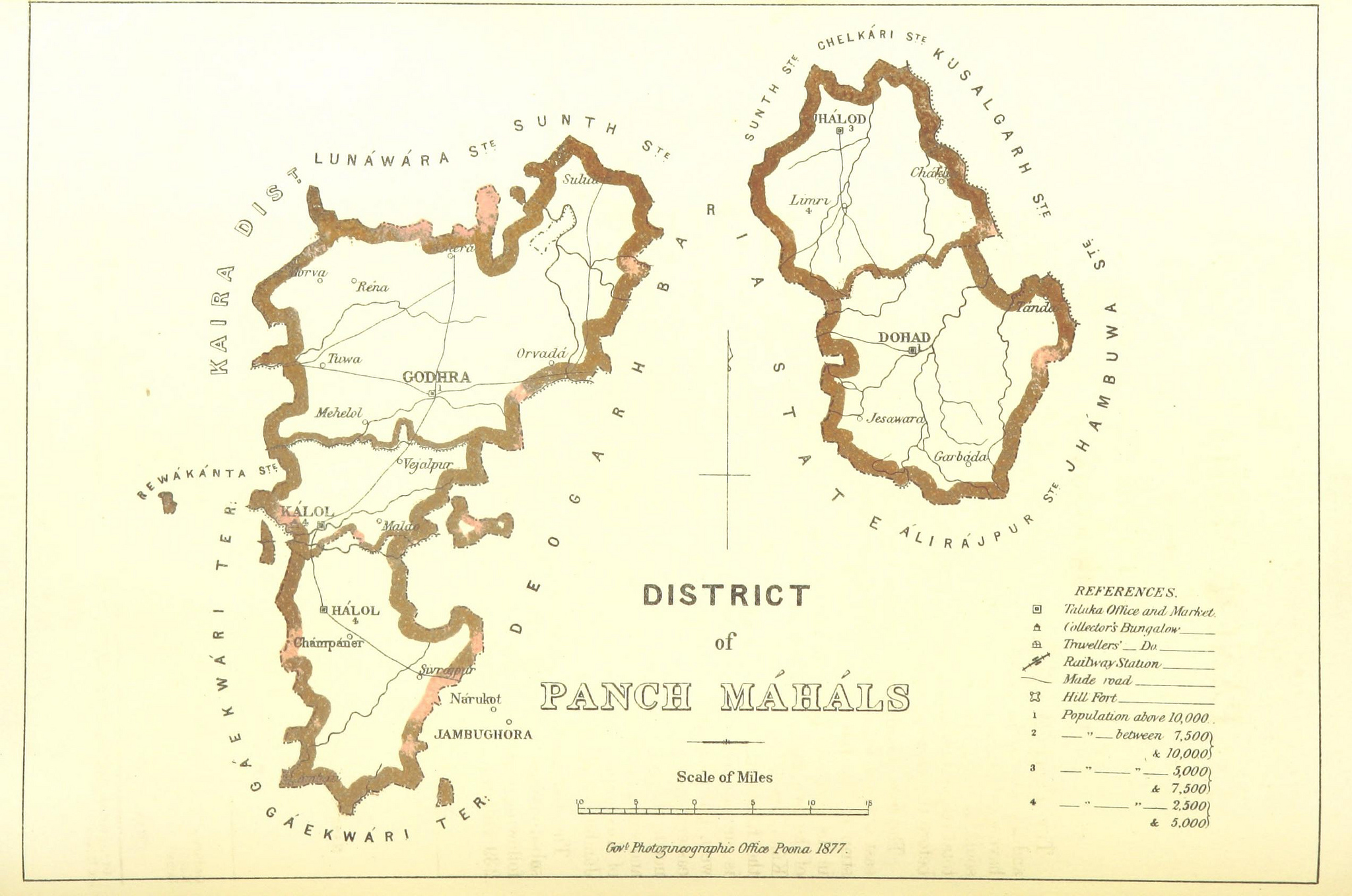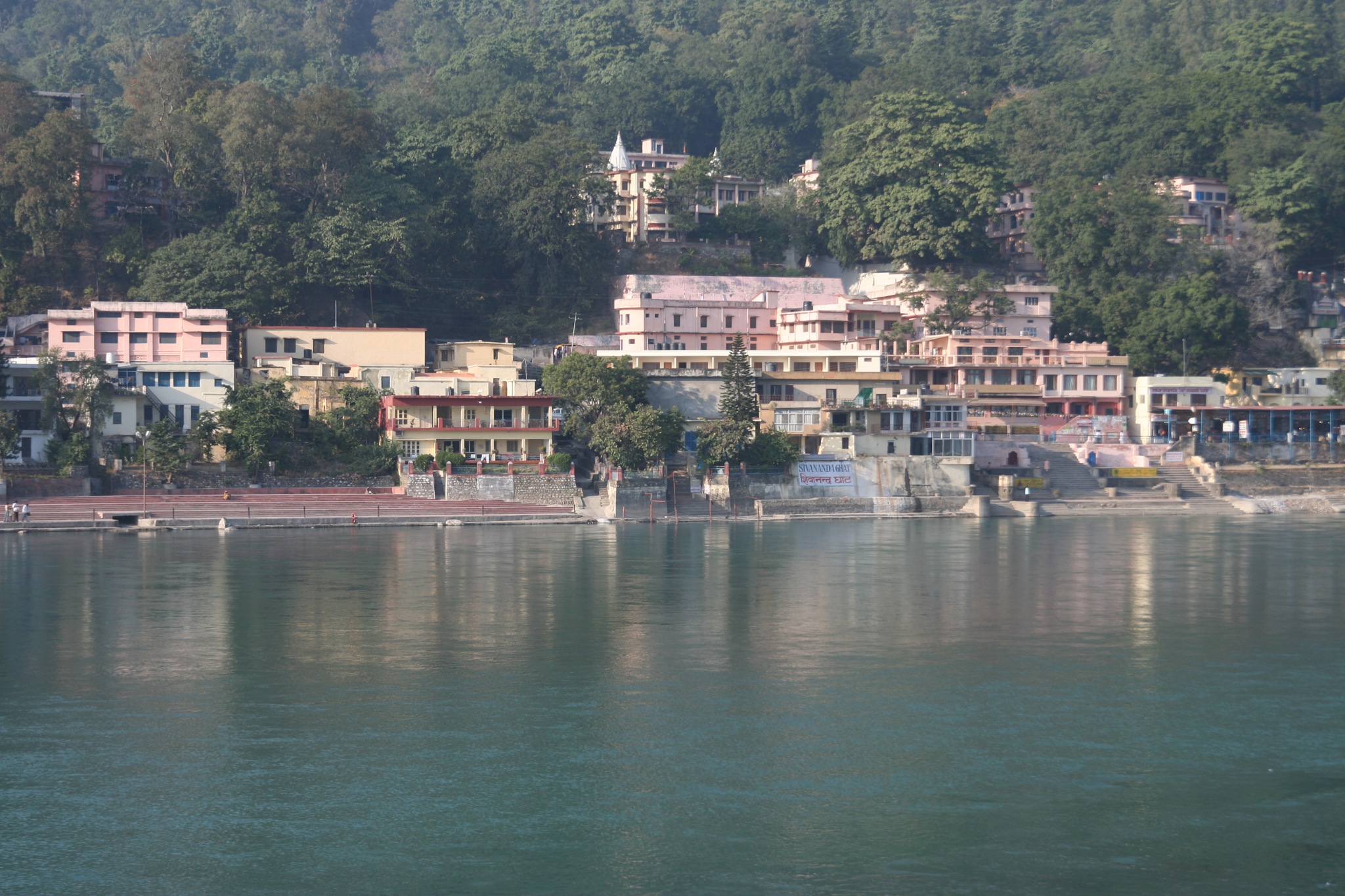|
Pavagadh
Pavagadh is an ancient Triassic Period location with Enriched History from periods of Treta Yuga and Dvapara Yuga. In present day, Pavagadh is a municipal operated region in Panchmahal district about away from Vadodara in Gujarat state in western India. It is known for a famous Mahakali temple which draws thousands of pilgrims every day. It is a tribal area populated predominantly by the Rathwas. The area of this locality Champaner-Pavagadh Archaeological Park was inscribed by UNESCO as a World Heritage Site in 2004. History It is said that king Vanraj Chavda established Champaner at the foot of Pavagadh in fond memory of his wise minister Champa. Later, the Patai Raval family ruled it and took care of the boundary. The folk tales say that Mahakali assumed the form of a woman and danced in a Garba during Navaratri. The last Patai, Jaisinh watched her with dirty looks. The deity became angry at Jaisinh and cursed him that the town will fall. The Muslim emperor of Gujarat, Ma ... [...More Info...] [...Related Items...] OR: [Wikipedia] [Google] [Baidu] |
Pavagadh Hill
Pavagadh Hill is situated within a plain in Panchmahal district, Gujarat, western India. A volcanic eruption occurred in the region approximately 500 million years ago and the etymology of Pavagadh is associated with this eruption: ''Pav-gadh'' means "one fourth hill" or "fire-hill". At its base is the historical city of Champaner, while the hill station of Pavagadh was built upon the volcanic cone itself. With Champaner, Pavagadh hill forms the Champaner-Pavagadh Archaeological Park, a UNESCO World Heritage Site which is spread over an area of more than . Known for its forts, there are also dozens of heritage structures on the hill. The site is east of Vadodara and south of Godhra. Faith based legend surrounding Pavagadh formation suggests that the right foot of Sati is believed to have fallen at Pavagadh, thus forming a deep valley and the God later on "sent a large hill as per the request of Rishi Vishwamitra to fill up this deep valley so that the sage's sacred cows do not ... [...More Info...] [...Related Items...] OR: [Wikipedia] [Google] [Baidu] |
Champaner-Pavagadh Archaeological Park
Champaner-Pavagadh Archaeological Park, a UNESCO World Heritage Site, is located in Panchmahal district in Gujarat, India. It is located around the historical city of Champaner, a city which was founded by Vanraj Chavda, the most prominent king of the Chavda Dynasty, in the eighth century. He named it after the name of his friend and general Champa, also known later as Champaraj. The heritage site is studded with forts with bastions starting from the hills of Pavagadh, and extending into the city of Champaner. The park's landscape includes archaeological, historic and living cultural heritage monuments such as chalcolithic sites, a hill fortress of an early Hindu capital, and remains of the 16th-century capital of the state of Gujarat. There are palaces, entrance gates and arches, mosques, tombs and temples, residential complexes, agricultural structures and water installations such as stepwells and tanks, dating from the eighth to the 14th centuries. The Kalika Mata Temple, loc ... [...More Info...] [...Related Items...] OR: [Wikipedia] [Google] [Baidu] |
Kalika Mata Temple, Pavagadh
Kālikā Mata Temple (or Kalikamata; ) is a Hindu goddess temple complex and pilgrim centre at the summit of Pavagadh Hill in Panchmahal District, India, with in the Champaner-Pavagadh Archaeological Park. It dates from the 10th or 11th centuries. The temple has three images of goddesses: the central image is of Kalika Mata, flanked by Kali on the right and Bahucharamata on the left. On Chitra sud 8, a fair is held at the temple which is attended by thousands of devotees. The temple is the site of one of the Great holy Shakti Peethas. One can easily reach the temple by ropeway. Geography Kalika Mata Temple is situated in the Indian state of Gujarat, near Halol, at above sea level. The temple complex is part of the Champaner-Pavagadh Archaeological Park, a UNESCO World Heritage Site. It is set amidst a dense forest cover on a cliff. The temple can be accessed by a pathway from the road head through the forest over a distance of . The path passes the ruins of Patai Raval' ... [...More Info...] [...Related Items...] OR: [Wikipedia] [Google] [Baidu] |
Mahmud Begada
Sultan Mahmud Begada or Mahmud Shah I (), was the most prominent Sultan of the Gujarat Sultanate. Raised to the throne at young age, he successfully captured Pavagadh and Junagadh forts in battles which gave him his name ''Begada''. He established Champaner as the capital. He was responsible for the destruction of the Dwarkadhish Temple in Dwarka, Gujarat, one of the Char Dhams considered sacred by Hindus. Names His full name was Abu'l Fath Nasir-ud-Din Mahmud Shah I. He was born Fat'h Khan or Fateh Khan. He titled himself, ''Sultân al-Barr, Sultân al-Bahr'', Sultan of the Land, Sultan of the Sea. Of the origin of Mahmúd's surname Begra or Begarha, two explanations are given in ''Bird’s History of Gujarát'' (p. 202) and ''Mirăt-i-Ahmedi'' (Persian Text, pp. 74): # From his mustachios being large and twisted like a bullock's horn, such a bullock being called Begado. # That the word comes from the Gujaráti ''be'', two, and ''gadh'', a fort, the people giving him ... [...More Info...] [...Related Items...] OR: [Wikipedia] [Google] [Baidu] |
Champaner
Champaner is a historical city in the state of Gujarat, in western India. It is located in Panchmahal district, 47 kilometres from the city of Vadodara. The city was briefly the capital of the Sultanate of Gujarat. History Champaner is named after Champa Bhil, a last Bhil king of Champaner. Champa Bhil built Champaner Fort He also established Champaner. During 1405, after Champa Bhil, Rajputs occupied Champaner. By the later 15th century, the Khichi Chauhan Rajputs held Pavagadh fort above the town of Champaner. The young Sultan of Gujarat, Mahmud Begada, deciding to attack Champaner, started towards it with his army on 4 December 1482. After defeating the Champaner army, Mahmud captured the town and besieged Pavagadh, the well-known hill-fortress, above Champaner, where king Jayasimha had taken refuge. He captured the Pavagadh fort on 21 November 1484, after a siege of 20 months. He then spent 23 years rebuilding and embellishing Champaner, which he renamed Muhammadabad, afte ... [...More Info...] [...Related Items...] OR: [Wikipedia] [Google] [Baidu] |
Panchmahal
Panchmahal, also known as Panch Mahals, is a district in the eastern portion of Gujarat State western India. ''Panch-mahal'' means "five tehsils/talukas" (5 sub-divisions), and refers to the five sub-divisions that were transferred by the Maharaja Jivajirao Scindia of Gwalior State to the British: Godhra, Dahod, Halol, Kalol and Jhalod, Devgadh Baria. The district had a population of 2,390,776 of which 12.51% were urban as of 2001. The district is located on eastern end of the state. It is bordered by Dahod district to the north-east & east, Vadodara district to the southwest and Chhota Udaipur district to southeast, Kheda district to the west and Mahisagar district to the north. Name ''Panch-mahal'' is a Hindustani or Gujarati word derived from Panch ("five") and Mahal which adopted from its original usage in Arabic for a place or type of building, later adopted in Hindi to refer to a province, district or its division, an estate etc. The district was originally called the P ... [...More Info...] [...Related Items...] OR: [Wikipedia] [Google] [Baidu] |
Panchmahal District
Panchmahal, also known as Panch Mahals, is a district in the eastern portion of Gujarat State western India. ''Panch-mahal'' means "five tehsils/talukas" (5 sub-divisions), and refers to the five sub-divisions that were transferred by the Maharaja Jivajirao Scindia of Gwalior State to the British: Godhra, Dahod, Halol, Kalol and Jhalod, Devgadh Baria. The district had a population of 2,390,776 of which 12.51% were urban as of 2001. The district is located on eastern end of the state. It is bordered by Dahod district to the north-east & east, Vadodara district to the southwest and Chhota Udaipur district to southeast, Kheda district to the west and Mahisagar district to the north. Name ''Panch-mahal'' is a Hindustani or Gujarati word derived from Panch ("five") and Mahal which adopted from its original usage in Arabic for a place or type of building, later adopted in Hindi to refer to a province, district or its division, an estate etc. The district was originally called the ... [...More Info...] [...Related Items...] OR: [Wikipedia] [Google] [Baidu] |
Halol
Halol is a city and a municipality (tehsil) in Panchmahal district in the Indian state of Gujarat. Located in western India, it has an average elevation of 499 metres (1637 feet). Halol is a major manufacturing hub of Western India, home to manufacturing facilities of numerous domestic and multinational companies like MG Motor India, Siemens Gamesa, JCB India, Hero Motocorp, Sun Pharma, TOTO India, CEAT Tyres, LM Wind Power, Polycab India, etc. Demography India census, Halol city had a population of 61000.{{cite web, url=http://www.censusindia.net/results/town.php?stad=A&state5=999, archive-url=https://web.archive.org/web/20040616075334/http://www.censusindia.net/results/town.php?stad=A&state5=999, archive-date=2004-06-16, title= Census of India 2001: Data from the 2001 Census, including cities, villages and towns (Provisional), access-date=2008-11-01, publisher= Census Commission of India Males constituted 53% of the population and females 47%. Halol had an avera ... [...More Info...] [...Related Items...] OR: [Wikipedia] [Google] [Baidu] |
Ashram
An ashram ( sa, आश्रम, ) is a spiritual hermitage or a monastery A monastery is a building or complex of buildings comprising the domestic quarters and workplaces of monastics, monks or nuns, whether living in communities or alone (hermits). A monastery generally includes a place reserved for prayer which ... in Indian religions. Etymology The Sanskrit noun is a thematic nominal derivative from the root 'toil' (< Proto-Indo-European, PIE *''ḱremh2'') with the prefix 'towards.' An ashram is a place where one strives towards a goal in a disciplined manner. Such a goal could be ascetic, spirituality, spiritual, yogic or any other. Overview  An ashram wo ...
An ashram wo ...
[...More Info...] [...Related Items...] OR: [Wikipedia] [Google] [Baidu] |
Path On Pavadagh Hill
A path is a route for physical travel – see Trail. Path or PATH may also refer to: Physical paths of different types * Bicycle path * Bridle path, used by people on horseback * Course (navigation), the intended path of a vehicle * Desire path, created by human or animal foot traffic * Footpath, intended for use only by pedestrians * Shared-use path, intended for multiple modes such as walking, bicycling, in-line skating or others * Sidewalk, a paved path along the side of a road * Hoggin, a buff-coloured gravel & clay pathway often seen in gardens of Stately Homes, Parks etc. * Trail, an unpaved lane or road Mathematics, physics, and computing * Path (computing), in file systems, the human-readable address of a resource ** PATH (variable), in computing, a way to specify a list of directories containing executable programs * Path (graph theory), a sequence of edges of a graph that form a trail ** st-connectivity problem, sometimes known as the "path problem" * Path (to ... [...More Info...] [...Related Items...] OR: [Wikipedia] [Google] [Baidu] |
Kalol (Panchmahal)
Kalol is a town and a municipality (tehsil) in Panchmahal district in the Indian States and territories of India, state of Gujarat. Geography Kalol is located at . It has an average elevation of 100 metres (328 feet). It has one pond. Industry Kalol and Halol (nearest city) constitute a Special Economic Zone (SEZ). Many big companies are located here like MG Cars, MG Car Company Limited (Morris Garages), Raychem RPG Pvt Ltd (RPG), AMBE International, SETCO Automotive, CEAT Limited, CEAT Tyres, GUNNEBO, Panchmahal Steel, Sintex Industries (plastic containers), Grandtech Engineering Works, Hero MotoCorp, INOX India Ltd., Plastichemix, DeviDayal Agro Chemicals, Bayer ABS, HNG Float Glass, Integra Engineering India Ltd ,Krishna Defense & Dairy Industries Ltd and many more. General Motors India Private Limited was shifted to Maharashtra State due to some separated reasons. Demographics As of 2001 census, Kalol had a population of 111,700, out of which 54% male and 4 ... [...More Info...] [...Related Items...] OR: [Wikipedia] [Google] [Baidu] |
Garba (dance)
Garba (Gujarati: ગરબા) is a form of Gujarati dance which originates from the state of Gujarat in India. The name is derived from the Sanskrit term ''Garbha'' . Many traditional garbas are performed around a centrally lit lamp or a picture or statue of the Goddess Shakti. Traditionally, it is performed during the nine-day Indian festival Navarātrī (Gujarati: નવરાત્રી, where નવ means 9, and રાત્રી means nights). Either the lamp (the ''Garba Deep'') or an image of the Goddess, Durga (also called ''Amba'') is placed in middle of concentric rings as an object of veneration. Etymology The word ''garba'' comes from the Sanskrit word for womb and so implies gestation or pregnancy — life. Traditionally, the dance is performed around a clay lantern with a light inside, called a ''Garbha Deep'' ("womb lamp"). This lantern represents life, and the fetus in the womb in particular. The dancers thus honor Durga, the feminine form of divinity. Garb ... [...More Info...] [...Related Items...] OR: [Wikipedia] [Google] [Baidu] |




